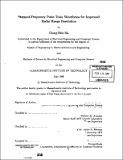Stepped-frequency pulse train waveforms for improved radar range resolution
Author(s)
Ma, Chung-Hsiu
DownloadFull printable version (8.123Mb)
Other Contributors
Massachusetts Institute of Technology. Dept. of Electrical Engineering and Computer Science.
Advisor
Herbert M. Aumann and James K. Roberge.
Terms of use
Metadata
Show full item recordAbstract
The traditional approach of improving radar range resolution using a linear frequency modulated chirp signal requires the full width of the frequency spectrum, which is not feasible in the UHF band due to interference or frequency allocation for other purposes. In this study a linear frequency modulated chirp signal is approximated using two stepped-frequency pulse train waveforms, a continuous wave pulse train and a linear frequency modulated pulse train. The continuous wave pulse train consists of a series of single frequency pulses, each at a different frequency. It is found to be susceptible to corruption due to target motion. The linear frequency modulated pulse train consists of linear frequency modulation within pulses, each at a different center frequency. Simulations are used to demonstrate that both approaches approximate a linear frequency modulated chirp signal, and performance is degraded when there is a gap in the frequency band or if there is phase distortion due to target motion. However, it is shown that a linear frequency modulated pulse train with frequency overlaps between pulses can be used to reduce or eliminate phase distortions resulting from target motion provided the target is moving with constant velocity. The validity of the technique is demonstrated by non-coherently processing radar data from an internal moving target simulator and data from actual planes to resolve targets from their reflected image in order to estimate target height.
Description
Thesis (S.B. and M.Eng.)--Massachusetts Institute of Technology, Dept. of Electrical Engineering and Computer Science, 1996. "June 1996." Includes bibliographical references (leaves 87-89).
Date issued
1996Department
Massachusetts Institute of Technology. Department of Electrical Engineering and Computer SciencePublisher
Massachusetts Institute of Technology
Keywords
Electrical Engineering and Computer Science.